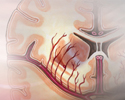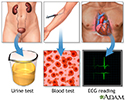High blood pressure - children
Hypertension - children; HBP - children; Pediatric hypertensionBlood pressure is a measurement of the force exerted against the walls of your arteries as your heart pumps blood to your body. High blood pressure (hypertension) is an increase in this force. This article focuses on high blood pressure in children, which is often a result of being overweight. Blood pressure readings are given as two numbers. ...
The Basics
Tests for high blood pressure tests
A Closer Look
Stroke - Animation
Stroke
Animation
Physical exam frequency - Animation
Physical exam frequency
Animation
Cholesterol and triglyceride test - Animation
Cholesterol and triglyceride test
Animation
High blood pressure tests
Routine lab tests are recommended before beginning treatment of high blood pressure to determine organ or tissue damage or other risk factors. These lab tests include urinalysis, blood cell count, blood chemistry (potassium, sodium, creatinine, fasting glucose, total cholesterol and HDL cholesterol), and an ECG (electrocardiogram). Additional tests may be recommended based on your condition.
High blood pressure tests
illustration
Stroke - Animation
Stroke
Animation
Physical exam frequency - Animation
Physical exam frequency
Animation
Cholesterol and triglyceride test - Animation
Cholesterol and triglyceride test
Animation
High blood pressure tests
Routine lab tests are recommended before beginning treatment of high blood pressure to determine organ or tissue damage or other risk factors. These lab tests include urinalysis, blood cell count, blood chemistry (potassium, sodium, creatinine, fasting glucose, total cholesterol and HDL cholesterol), and an ECG (electrocardiogram). Additional tests may be recommended based on your condition.
High blood pressure tests
illustration
High blood pressure - children
Hypertension - children; HBP - children; Pediatric hypertensionBlood pressure is a measurement of the force exerted against the walls of your arteries as your heart pumps blood to your body. High blood pressure (hypertension) is an increase in this force. This article focuses on high blood pressure in children, which is often a result of being overweight. Blood pressure readings are given as two numbers. ...
The Basics
Tests for high blood pressure tests
A Closer Look
High blood pressure - children
Hypertension - children; HBP - children; Pediatric hypertensionBlood pressure is a measurement of the force exerted against the walls of your arteries as your heart pumps blood to your body. High blood pressure (hypertension) is an increase in this force. This article focuses on high blood pressure in children, which is often a result of being overweight. Blood pressure readings are given as two numbers. ...
The Basics
Tests for high blood pressure tests
A Closer Look
Review Date: 7/31/2024
Reviewed By: Charles I. Schwartz, MD, FAAP, Clinical Assistant Professor of Pediatrics, Perelman School of Medicine at the University of Pennsylvania, General Pediatrician at PennCare for Kids, Phoenixville, PA. Also reviewed by David C. Dugdale, MD, Medical Director, Brenda Conaway, Editorial Director, and the A.D.A.M. Editorial team.




